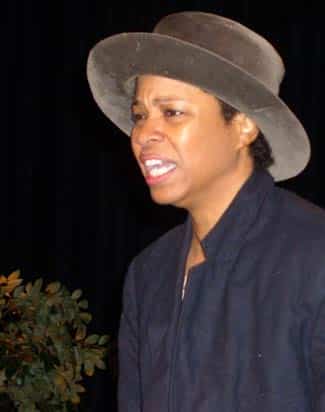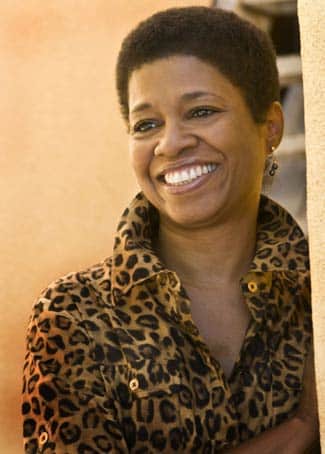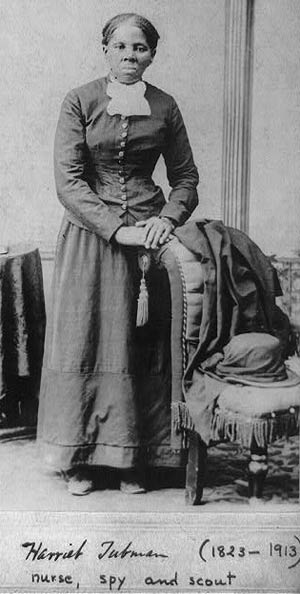by Karen Jones Meadows
As a child I learned of Harriet Tubman, icon of the anti-enslavement movement, and the most celebrated “conductor” on the Underground Railroad, a network of diverse citizens in the U.S. and abroad who ushered enslaved people to safe states and countries. I had no idea Harriet Tubman would become an intricate and intimate fixture in my world, leading, sometimes dragging me, into successive levels of life and creativity.
My first adult encounter with Harriet was when I was commissioned to create a series of one-woman performances entitled, A Living Portrait of Black History. I chose to embody Queen Nzinga, Lorraine Hansberry, Phillis Wheatley and Harriet Tubman through extemporaneous monologues followed by in-character Q&A sessions. Audiences from kindergarteners to avid theater goers were dazzled by Queen Nzinga’s Angolan accent, tales of fighting the Portuguese and regal defiant presence; Lorraine Hansberry’s fiery socio-political opinions and undercurrent of vulnerability left people thinking abstractly; but it was Harriet Tubman who became the most requested.

She ignored my well-researched information and complex characterization—men’s trousers tied with ragged cloth, plaid shirt, a hat pulled over her scar, carrying a stick I’d carefully chosen—and say and do whatever she wanted, like; I visits dem other womens. Phillis Wheatley good wit dem poetry words but didn’ have no common sense, which is how she end up dead froze ta death on Queen Street in Boston. If I’d been alive when she was, I woulda— This would be about the time I’d freak out, not knowing how “we” were going to get out of this diatribe she’d started. Somehow we always did, in a perfectly logical and theatrically meaningful way.
I soon set out to launch my playwriting career minus Harriet and the others. My first New York production, Henrietta, was a success by most accounts, and I was feeling on-my-way in my red hat, wandering up Madison Avenue somewhere between the 50s and 60s when a well dressed executive-looking white man approached and asked, “Do you know anything about Harriet Tubman?”
Odd, but okay. I’ll share. As we walked, I told him things, such as, Harriet’s real name, Araminta, as was her mother’s, and that people called her Minty when she young. As a pre-teen, her skull was crushed by a man who hit her with a weight for attempting to assist someone escaping. She heard voices all her life, some attributing it to the brain injury, some not. I’m sure I told him that her romances intrigued me and I wanted people to know about them because they counter the usual stoic, hardened looking pictures of Harriet, when in fact the reason she didn’t smile was because her teeth embarrassed her, which I learned from her great-grandniece.
Man I ain’t nevah seed befo’ come walkin’ round de edge o’ de plantation. I ain’t seed no black man walk like dat. His att’tude de mos’ finess’ o’ anybody I know. Rachel, were plantin’ flowers, an’ me pullin’ weeds. She see me lookin’ at him, say, “He free, he don’ want you.” He come up close now, ’cause we werkin’ near de paff by de fence. I draws mysef up, smiles, an’ waves my weeds while I laughs, lack I seed de slaveholda womens do wit dey hank’chiefs ta show dey fineness…Don’ nevah im’tate somebody, ’cause ya jes’ come out lookin’ lack a fool…

After another New York play, Tapman, with many excellent reviews and one devastating one that almost made me stop writing, I secured work with McMillan-McGraw Hill, creating CDs to teach children an appreciation for global music. How could an obscure Harriet Tubman opera for me to condense into seven minutes come into this picture? Had to be Harriet. Persistent… Relentless…Resourceful…Never going to leave me alone…Harriet. She even had the head of a writing workshop where I gave occasional classes suggest I write a one-woman play about “guess who” and perform it in New York.
Did no one understand that I actually had a life plan and being the incarnate of Harriet Tubman wasn’t in it? Admiration is one thing; submission, another.
Then Harriet went into the no-fair zone. Ron Milner, great playwright and friend, asked me to write a children’s version of Harriet Tubman for his theatre’s youth outreach program. He repeatedly emphasized that it was for our starved-for-truth children, and he even had some commission money. Did I mention Harriet loved children?
When I had performed in schools, upon seeing “Harriet,” the African-descended youth first had horror on their faces, but their chests were fully expanded by the end. The pride of the power and ingenuity of our ancestors who were Africans, from real places with substantial histories — not a color, black, devoid of human qualities that left one’s heart aching for inclusion and validity — filled them. By the time Harriet left, they were on their way to exploring their individual worlds and the world beyond whatever limitation had been thrust into their psyches.
Always the term “enslaved” was used in place of “slave,” as Harriet explained—
Iffin I takes dis stick, slam ya in yo’ head wit it, stab ya, hol’ it ta yo’ face, say, Bark dog! BARK DOG! Ya’ll bark. Jump. Scratch. RoII ovah–Do all manna o’ thangs ya be ‘sprised ‘bout. Now, do it make ya a dog, or a person force’ ta ack lack a dog? We was peoples force ta ack lack slaves, but t’wernt ne’re one o’ us no slave.
I set out to write what I thought would be an easy script. I still had research notes, and some familiar lines, and I’d keep the contemporary context in the beginning — I always knew that to be heard, the story would have to relate to the “now” audience. I had to make sure that any actress and director who interpreted this play would hit all the salient points that mattered to Harriet.
| I actually had a life plan and being the incarnate of Harriet Tubman wasn’t in it. |
She was working from the inside out. She was working me so hard that it became apparent that she wanted a big context in which to roam and that, yes, I would finish the children’s piece, but then it was on to the grown folk’s production, and she didn’t care how many drafts I had to write to get it done.
I’d bemoan the emotional savagery of digging through the period of enslavement—it would make my solar plexus so raw with feelings that my torso ached. I cried while grocery shopping, overwhelmed with sadness. I would remember personal experiences, and incorporate them into the text…
When I drive down 1-85 or 1-77, I don’t see cherry blossom lined highways. I see sweat rolling down the backs of enslaved laborers–humped back women and glass eyed men with pus in their hands and cracks in their feet from picking whatever the overseers tells them for the day. The Ancestors and the Voices that guide me are calling me now…
I could feel her keeping me company, quietly watching over our work. I had direct linage ancestors showing up, and my own cellular recall, and they weren’t always of African descent. Writing in dialect that was understandable was tedious and subjective.
I kept doing research. Had to get in that she made 19 journeys back into southern territories to emancipate other enslaved people after she’s secured her own freedom. She was an herbalist and nurse, entrepreneur, army strategist who led troops during the Civil War. She owned 25 acres of land, when neither women nor African-descended people were “allowed’ to do so. She supported schools and hospitals, had a boarding home for those in need, and was a leader in the women’s suffrage movement. She did all this while enduring great physical and economic challenges.
I had to not make it a big history lesson, or indictment; had to have humor; had to have her husbands — yes, plural. My computer broke. I was tired, cold, hungry, and perhaps not that bright. A whisper breathed into me, “Are you running in the snow from Maryland to Canada leading a group of terrified people while other folk are trying to hunt you down and kill you?”

De riva shine lack it made o’ ice. Step in de cold come ovah me–feel lack I gon’ crack open. Noder step go unda, droppin’ furva an’ furva, aint’ nevah comin’ up! My Voices! Where’ dey?! Why dey didn’ tell me?! Cain’t swim! Please! Help Me! Voices say, “Float!” I cain’t, I’ma drown!
HARRIET’S RETURN: Based Upon the Legendary Life of Harriet Tubman was born. The first professional incarnation of the play was at Crossroads Theatre in New Jersey with Ricardo Khan directing and Trazana Beverley in the role. They were both masterful. During that rehearsal period I added “Selena’s” scene—Selena is a girl Harriet finds in the woods after she’s been separated for two years from her escaping parents. Adding a percussionist was also introduced there. I was thrilled. The process was fun. Harriet was happy. After that, many fine actors, directors and theaters played to a multitude of audiences who marveled at their tender, beautiful interpretations of the adult and youth versions.
I could relax.
A non-theatrical producing organization made an offer to present the play. They needed a self-contained production, one that could just move into a rented theater for a fundraising event. All who’d done it were involved in other projects. I searched for actresses. The date was nearing. I could feel Harriet on me. I had no desire to learn 46 pages of solid dialogue and do a lot of running and jumping and exuding of the emotions of 30 characters. I hadn’t been on stage in many years.
Harriet made me. She made me revisit the script and do a few nuance changes she’d cooked up. She chose the director, Jake Walker, who made me do some kind of yoga that made me regurgitate, which he thought a good thing, and then she made designer David Ode step in, thus rounding out our physically small and soulfully big touring production.
Many states and few abroad productions later, I mostly travel alone now. Well, that’s not true. I’ve got Harriet and she’s got me. We are each other’s voice…
All back den an’ me, we’s Voices now. An’ we keeps hearin’ ya’ll call. An’ we really tries ta do our bes’, an’ we assin’ y’all ta do yours, ’cause some o’ us real tired, an’ all y’all powaful ya own sef…
Karen Jones Meadows, author of HARRIET’S RETURN: Based Upon the Legendary Life of Harriet Tubman is a healing artist, working as a writer, actress, intuitive medium, arts- in-education specialist and workshop facilitator. She creates stories and environments that inspire people to align in practice with their highest intentions. She can be reached at [email protected] or www.harrietsreturn.com.
Also see Film Review: Liberian Women Forge a Real-Life Lysistrata by Jaye Austin Williams in this edition of On The Issues Magazine.
See The African American Woman Who Shaped the Future of Art by Ms. Michael angel Johnson in The Cafe of this edition of On The Issues Magazine.
Visit The Café of On The Issues Magazine for new stories and updates.
